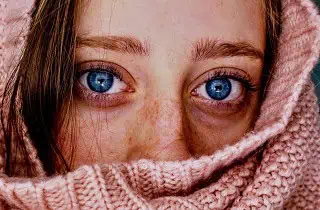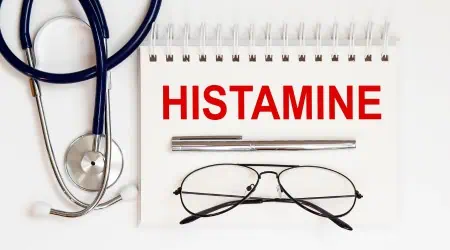
Mast cell activation and histamine can play a role in premenstrual syndrome (PMS) and premenstrual dysphoric disorder (PMDD).
That’s why mid-cycle, premenstrual, and perimenopausal mood symptoms can be relieved by antihistamines and natural histamine-reducing strategies such as quercetin, vitamin B6, SAM-e, and a dairy-free diet.
What are mast cells and histamine?
Mast cells are immune cells that release prostaglandins, inflammatory cytokines, and histamine. Histamine is an immune-signaling amine that causes allergies and swelling but has many other effects. For example, histamine regulates stomach acid, ovulation, and libido, which is why estrogen increases libido and antihistamines decrease it.
Histamine is also a stimulating neurotransmitter that can cause anxiety and insomnia.
Symptoms of mast cell activation and high histamine include:
- urticaria (hives), including dermatographia
- nasal congestion
- low blood pressure
- joint pain
- fluid retention
- tinnitus (ringing in the ears)
- nausea
- diarrhea
- irritability
- insomnia
- brain fog
- breast tenderness
- headaches or migraines.
The final few symptoms of irritability, insomnia, breast tenderness, and headaches are all typical symptoms of PMS, which makes sense because histamine rises and falls with estrogen. Histamine is highest just before ovulation and during the luteal phase.

Is histamine playing a role in your premenstrual mood symptoms?
The first step is to try over-the-counter antihistamine medication such as diphenhydramine (drowsy) or loratadine (non-drowsy) to see if it helps. (There have also been reports of PMDD symptoms improving with the antihistamine famotidine, brand names Pepcid and Zantac.) If it helps, then histamine is likely to be a primary driver of your PMS or PMDD. You will also likely have one or more of the following signs and symptoms:
- Anxiety and other mood symptoms just before ovulation when estrogen is high.
- Headaches or migraines that can be relieved by antihistamines.
- Dermatographia, which is the appearance of raised, reddish marks after light scratching of the skin.
- Breast pain because histamine and mast cells are directly involved in breast pain and fibrocystic breast disease.
- Period pain because histamine causes pain.
If an antihistamine does not help, you need to consider other factors in premenstrual mood, such as high prolactin, iodine deficiency, and progesterone sensitivity.
How to lower histamine and relieve PMS and PMDD
- Reduce mast cell-stimulating foods such as alcohol and cow’s dairy. Read What dairy does to periods.
- Reduce histamine-containing foods such as red wine, cheese, avocado, tomato, bone broth, and fermented foods (including sauerkraut and kombucha).
- Take a histamine-reducing supplement such as quercetin, magnesium, SAMe, or vitamin B6.
- Take natural progesterone because it up-regulates the DAO enzyme that clears histamine. Progesterone capsules can also overcome the progesterone sensitivity associated with PMDD.
👉 Tip: Histamine reduction is a big part of why magnesium, vitamin B6, and natural progesterone work so well for PMS and other women’s health conditions.
What is your experience with PMS and PMDD?
For more, read:
- High histamine can make for a tougher perimenopause
- Top 6 natural treatments for premenstrual mood symptoms
